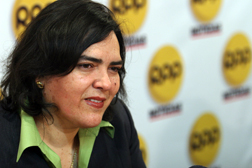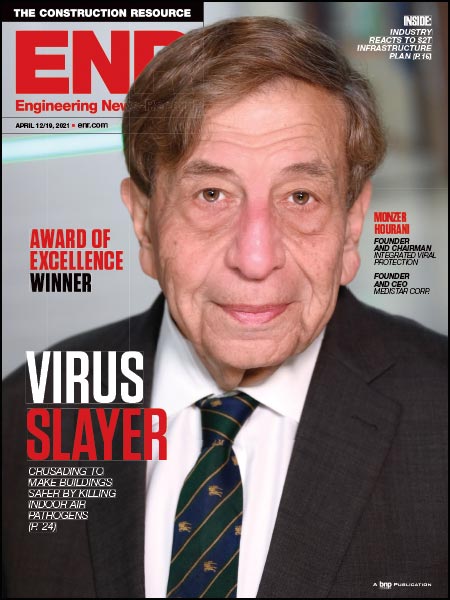With the election of Peruvian President Alan Garcia last July, one of the key priorities of the new administration was continuing the economic progress and a major aspect of that has been infrastructure.
 La Republica Zavala grapples with a highway system in a state of disrepair. |
The $1.3-billion InterOceanic Highway Project is just one of the major infrastructure projects currently underway in Peru. Major road projects in the north and central highlands are under way as well as a massive ongoing upgrade program.
Overseeing that is the new Minister of Transportation Vernica Zavala Lombardi. The Harvard-trained lawyer previously served as the executive director of the countrys public holding company oversight agency. Her background includes extensive work in regulation of public services.
The ministry oversees the more than the more than 78,600 kilometers of roadways in the country. Less than 10,500 km are paved. Similarly, the ministry also is responsible for the countrys 268 airports, but only 54 have paved runways. It also oversees the three main coastal ports as well as two primary river ports in the Amazon.
What is the priority for the Ministry of Transportation over the next five years?
The gap we have in infrastructure here in Peru is much larger than many of our neighbors. To address this, we want to increase the investment into infrastructure to represent a greater portion of the GDP. Currently that is at 1.9 percent and the government and the executive branch want to increase that to 4 percent.
How does the administration want to address this issue?
We are focusing all of our efforts in order to maintain a 7 percent rate of growth. That is the goal. A great deal of that has to do with the economic side of things and, for our part; we want to be able to increase the level of investment substantially over the next five years. One of the primary goals of this is to foster economic decentralization where everything will not have to come to Lima.
What role does your ministry play in that strategy?
Better infrastructure will create new avenues of commerce. If you look at the infrastructure of the interior of the country you see that most of the rural areas simply have no access to any markets. The mountains and jungles of the interior are essentially locked away from the markets on the coast and Lima.
Is this different than in years past?
We are not inventing anything. We have a very thorough, multi-modal transport plan for the next twenty years. We are now working on how to implement that. One of the key parts of that is the road system we have discussed. In some parts of the Amazon areas we will focus on the rivers and we will work on the regional ports. We have signed concessions to run a group of airports in the northern region and we are working on doing the same for a number of airports in the south.
What is the current state of ground transportation infrastructure in Peru?
We need to improve the quality of our roads. Only about 25 percent of our road system is in good shape. We want to improve that to 45 percent. That means we are looking to do efficient investments. We do not have to have roads with asphalt when there isnt a demand for that type of road.
|
What caused this situation?
In the past we have tended to build more than we can maintain. The priority will be upgrading the roads that exist. We will have to build some new roads but our main effort will focus on improving the roads that we have already. We want to improve 100 percent of the roads that make up the national highway system. That makes up about 8,500 kilometers of roadways. Of that 66 percent is in need of repair.
Is that a realistic goal?
In general terms we feel the prospects are very good. We have more economic tools at our disposal than we have had in the past. The economic fundamentals are very strong and it gives us the opportunity to prioritize the countrys infrastructure. If work very hard on all these road projects it will strengthen, for example, the countrys exports. Products that are locked in many geographical areas will have access to markets. In this sense, the infrastructure is an economic base.
What is your strategy to do this?
I want to prioritize maintaining roads and build using the concept of transitablity where you build to regular standards but you dont apply the asphalt. Its often better to have these types of road and, after it degrades, rebuild it rather than to have an asphalt road and not maintain it, which means you have to rebuild the entire road. In that case you lose a huge investment because you didnt have the money to maintain it.
What is the main obstacle you face?
Not every department has the financial resources to conduct their own infrastructure development and improvement. We are working with these departments so they can put their resources with the resources of the local governments and take on more of their own infrastructure improvement. We want balanced development and to do that it is important we include every area of the country.
How can your ministry achieve that?
This MTC will provide technical assistance so the regional government can focus on the planning and the work on the projects themselves. This will also be in place to help the local government handle road management and maintenance. We will continue to take care of the national roads while offering greater technical assistance to these regional governments to maintain the departmental roadways.
Are there difficulties synchronizing the efforts at the national and departmental level?
The problem I face is that all the departments in the country have at least one big dream and they are each pushing for that specific goal. I have to be aware of all of these but I also have to keep in mind the 20-year plan. So I end up having to make decisions. There is a need to balance all of these priorities to take the path that is best for the country as a whole. The main issue is how to properly allocate scare resources.
What is the economic situation you are dealing with to do this?
We have a list of projects we want to start work on but we lack the financing to do so right up front. So we are looking at Public Private Partnerships in order to make these feasible while allowing us to work on the upkeep of the roads we already do have.
Other countries in the region have had difficulty implementing their concession systems, has this been the case in Peru?
We are optimistic about the system but it is something we cannot be 100 percent sure about until it is put into practice. We dont have that many concessions to know what needs to be improved. We really have just started. We think our system is relatively good but we cannot be certain because the system is quite young.
Are there other funding avenues you are pursuing?
We are working on the efficiency side with our toll system. Right now our toll roads collect only about half of what is needed to maintain the roadways themselves. We think we can bring in outsourcing for part of that and concessions for the other part of that. We are working on different schemes to deal with it.
How do these objectives help Perus construction sector?
We want to see Perus construction sector grow, we want more participants and we want more opportunities for the companies currently that make up that sector. Right now there are not any Peruvian companies of the size needed to lead projects of this size. The financial structure of the contracts are being done in such a way that more firms can participate.
 Related Links:
Related Links: 


Post a comment to this article
Report Abusive Comment